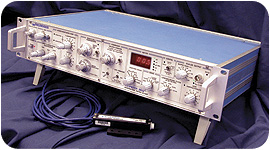Axon Axopatch 200B Microelectrode Amplifier
Low-noise patch-clamp amplifier. Open input noise is reduced to unprecedentedly low values. This reduces noise in real measurements, which is achieved by cooling the input field-effect transistors to below 0 degrees Celsius.
- Overview
- Specifications
Key Features
- Current and voltage patch clamp amplifier with extremely low noise
- Accommodates any data collecting system
- Suited for single-channel and whole-cell recordings
- Three recording modes for currents ranging from sub-pA to hundreds of nA
The newest version of Axon™'s top patch-clamp amplifier, the Axopatch™ 200B, uses cutting-edge capacitor-feedback technology to deliver the lowest-noise single-channel recording currently possible. With the help of this unique technology, the manufacturer has improved the integrating patch clamp amplifier, achieving the lowest electrical noise possible by cooling the amplifier's active components. No other amplifier provides this minimal noise. With Axon's thin headstage design that enhances access to the preparation, positioning an electrode will also be simpler.
Other improvements include three recording setups in a single headstage (one patch and two whole cell ranges, with capacitance compensation ranges of 100 pF and 1000 pF), enhanced voltage and current command ranges for electrochemical measurements, built-in capacitance dithering functionality for capacitance measurements, and the inclusion of series resistance compensation to the current clamp circuitry to enhance performance. The Seal Test now offers voltage steps in voltage clamp mode in addition to current steps in current clamp mode. The most critical resistance range is currently where Leak Subtraction is most sensitive. The recording bandwidth has been doubled to up to 100 kHz, and the small headstage design enhances electrode access to the setup.
When a patch-pipette holder is added to the headstage input and the pipette capacitance is fully corrected, the incredibly low open-circuit noise of 0.13 pA rms (10 kHz) climbs to only 0.145 pA RMS (to eliminate capacitance charging transients). Cooled capacitor-feedback technology is even more effective than capacitor feedback and is definitely superior than resistive feedback.
The Axopatch™ 200B Amplifier, like its forerunners, uses capacitive and resistive feedback elements in its headstage to deliver the greatest possible performance for whole-cell and single-channel patch clamp experiments. Convenient features include Holding Command, which allows you to set voltage commands in voltage clamp mode and current commands in current clamp mode, ZAP (to rupture patches when going whole cell), dual-speed current clamp (to allow faster current clamping in small cells), and an option of three gain settings on the specialized current output (for patch, whole-cell and loose-patch modes).


